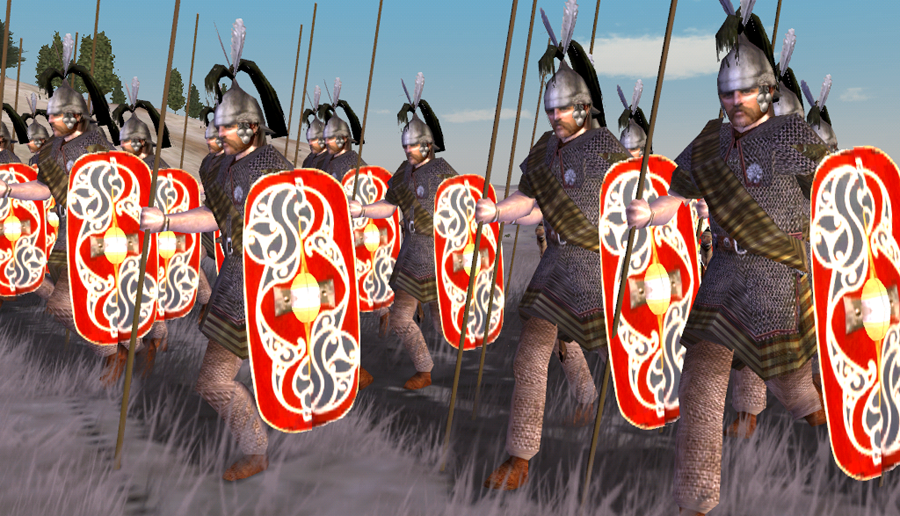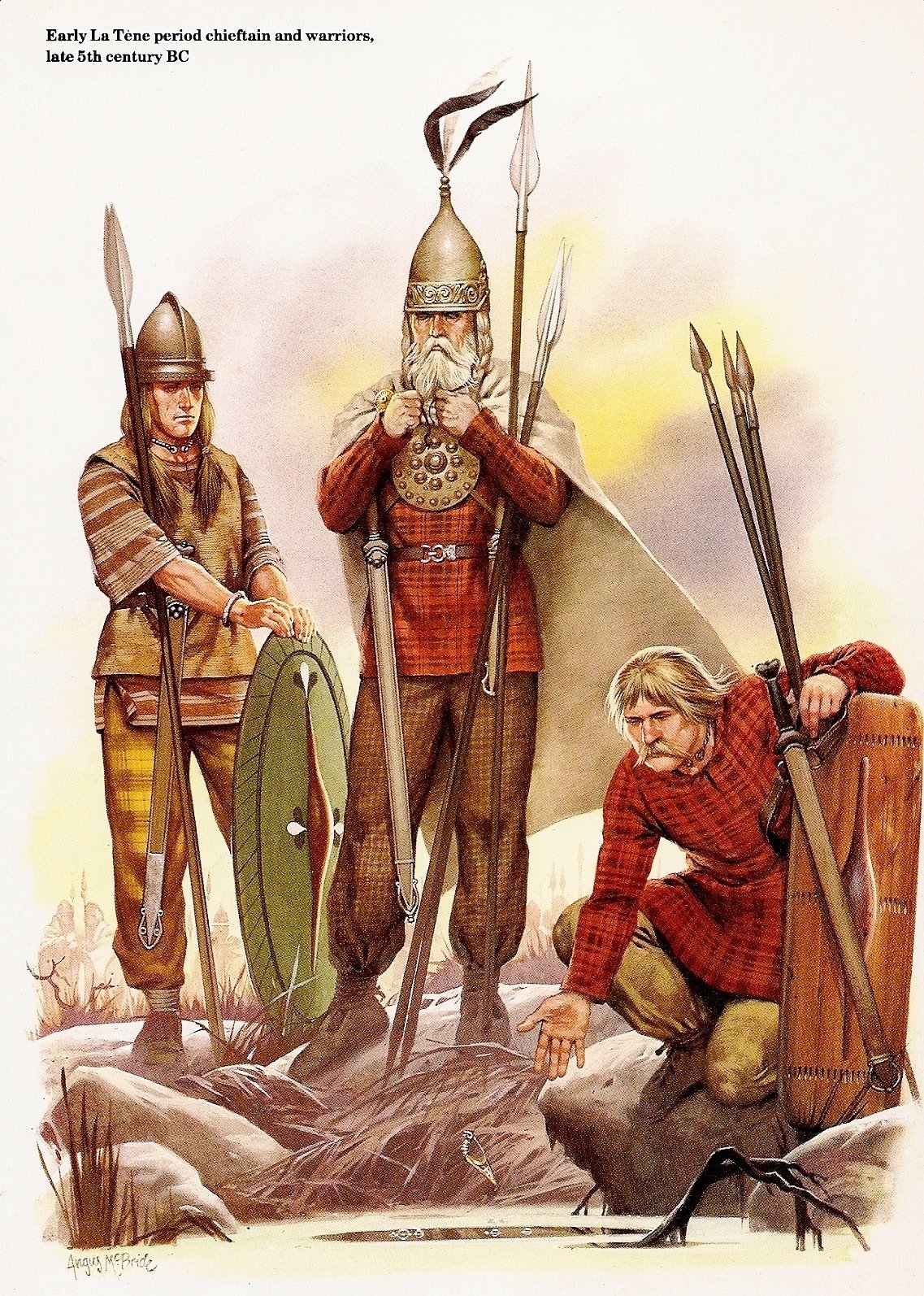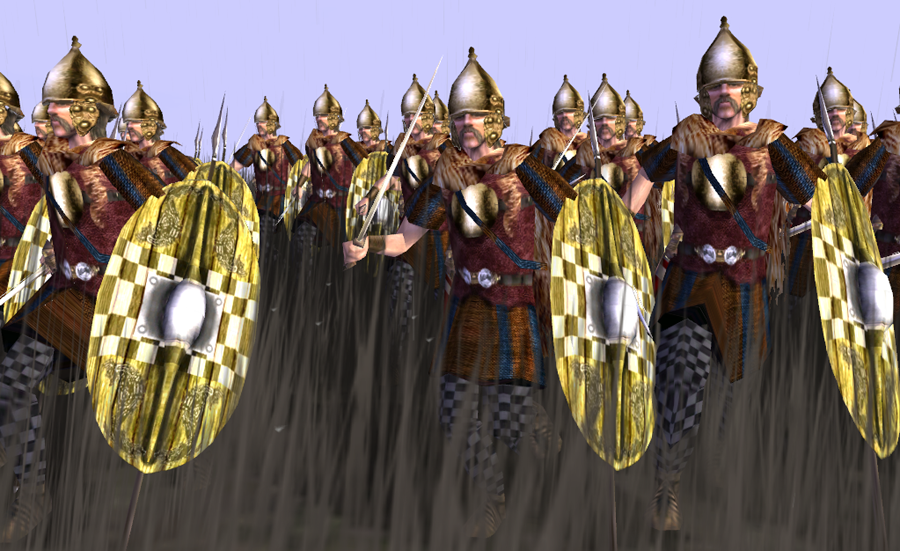
A definition: Those who march together
The best possible ancient Gallic "Cingetos" when deconstructed means "those who march together", and was interpreted simply as the [Professional] warriors. Simply put, the warrior class. As a whole, the celtic warrior class should be the object of several articles. The description was a metaphor for professionalism, applied to the discipline of seasoned warriors which use to train and fight together, and notably to the Celtic early formation. This has very much to do with the early tactics of the Gauls, circa 400-300 BC. In later periods as shown by the quilts and fixation systems of swords, mobility became the norm, the charge became a tactic all by itself and the Gauls relied more on psychological warfare.However, probably under the influence of Estruscan and Greek warfare, Celts either adopted, imitated, or emulated the phalanx. Such formation was only possible for well-trained soldiers, in that case the warrior class, also called "Cingetoi" in combat. The grammar was Greek and therefore the term was rather Kingetos (Plur. Kingetoi). By practice of the term, meaning a deliberate, close formation relying on discipline, a type of spear-first elite warrior began to emerge.
Indeed as a consummate professional, a Kingetoi was first a spearmen, able to either form a defensive "turtle" or shieldwall (as shown by the Helvetii during Caesar's conquest in De Bello Gallico), but were able to march in close formation to break the enemy. One cannot charge like this. Therefore the Kingetoi were the embodiment of the Celtic "phalanx", a slow-moving, (very) densely pack of heavy spearmen, supposedly well protected.
Status and equipment of the Cingetoi
As a professional warrior by trade, a Cingetoi was part of the warrior class. This was not a perfectly uniform one. Warriors were in general better equipped than militias and part-time combatants such as the "Atectoi", peasant levies, or "Bagaudoi", trained peasants for war, or "Gaseatoi", spears/javelin carriers, which formed the soft mass of the infantry; Sword carriers were all found in the warrior class, due to the cost of the sword. Given the Celtic clientelism, it's always possible the wealthiest warriors had their own followers and servants ("ambacts"), less well equipped, carrying javelins, short spears, daggers and axes. Therefore there was a "grey zone" in between the peasantry and warriors.
As well-trained professional, Cingetoi were supposed to master and possess a sword and a spear, and afford a good protection. Not your usual spear. These were at the beginning "lancias", three meters long spears wielding an impressive spearpoint, with a very large and intimidating leaf-shaped one. They were not easy to handle and were in fact used both fo defense, and offense in packed formation. Naturally excellent against cavalry, these Lancias could be quite effective against a melee, pushing forwards. They are undoubtely spears due to the size and shape of their spearpoint, by contrast to the warrior on the right, a semi-professional skirmisher ("acubagaudoi" or gaesatoi") showing his javelins and their small spearpoints. A professional as his javelins are heavy and of good quality. Peasants probably used cruder javelins in time of war, without spearpoint but a sharpened end, hardened by fire. He also has a torc and a sword, showing he also is part of the warrior class and a "cingetoi" in a broader sense.

The warrior to the left seems to be a Cingetoi, client warrior of a lesser noble in the 5th Century BC, at the time of the first invasions of Northern Italy. He is wielding two gae, not lancias as they are too light and short. In addition he is carrying two for them, implying he could throw one and use the other for close protection. He also has a longsword, so undoubtely of the warrior class. The apparent lack of body armor was all relative, as he probably had a leather jacket under his cloth.
Swords of course fo the Cingetoi are the secondary weapon of choice. In 400-300 BC they were about 70-80 cm long. It looks massive and unwieldy, but that type of sword, acording to Polybius and others was mainly used for slashing. A sword was a pricy item, more so than even the Lancias and their often well-worked spearpoint, having holes, damasked decorations or a particular shape. But not all swords were of an equal quality. Due to a simplified process, it was possible to forge one of several unsophisticated swords in a single day in a vilage forge, whereheas elite client warriors and their masters, nobles (Arjoi) ordered swords by expert craftsmen, the one working in the oppida military forge. Such sword could take a week or more with a complex and repeated process to include more carbon (hardened steel shell) with a softer steel, or iron inside for flexibility. This was added to a lavishly decorated pummel guard and scabbard. Gauls were not known for having smaller knife or dagger. None was found.
Protection-wise, Cingetoi of the upper rank, the heavy spearmen, probably had both a helmet, and body protection. For helmets, the most popular model around the VI-VIIth Centuries was the Illyrian pot model, and tall, pointy models (such as the later "Marne". Until around 400-300 BC and the 200s, the conical Montefortino model reigned supreme. But the "coolus" or "jockey cap" became immensely popular in particular for its generous paragnathids (cheek guards).

Sources
De Bello Gallicowikipedua (about the aquitani, Sotiates and Adcantuannus)
Dialogues d'histoire ancienne: By Centre de recherches d'histoire ancienne
♕ Aquitani & Vasci ♕ Celts ♕ Indo-greeks ♕ Veneti ♕ Yuezhi ♕ Indians ♕ Etruscans ♕ Numidians ♕ Samnites ♕ Judaean ♕ Ancient Chinese ♕ Corsico-Sardinians
⚔ Cingetos ⚔ Immortals ⚔ Cavaros ⚔ Cataphract ⚔ Romphaiorioi ⚔ Chalkaspidai ⚔ Devotio Warrior ⚔ Scythian Horse archer ⚔ The Ambactos ⚔ Iberian warfare ⚔ Illyrian warriors ⚔ Germanic spearmen ⚔ Carthaginian Hoplite ⚔ Thracian Peltast ⚔ Caetrati ⚔ Ensiferi ⚔ Hippakontistai ⚔ Hastati ⚔ Gaesatae ⚔ Cretan Archer ⚔ Thorakitai ⚔ Soldurii ⚔ Iphikrates ⚔ Kardaka ⚔ The thureophoroi